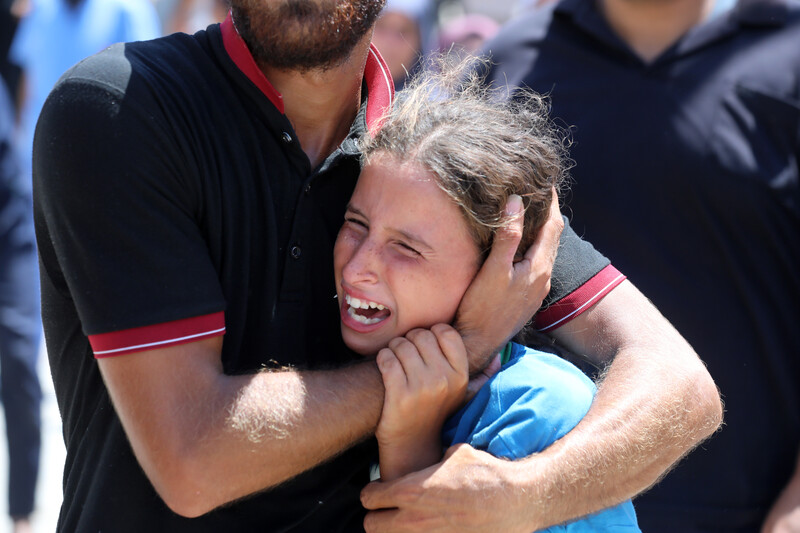The Electronic Intifada 17 July 2024

Israel killed at least 90 people in Mawasi in several airstrikes on an area the military had designated as a “safe zone.” Here a child reacts as bodies are salvaged from the site on 13 July.
APA imagesUnder a scorching sun last Saturday, 14-year-old Tala Mahmoud was waiting in a food distribution line to secure a dish of lentils for her family in the displaced persons’ camp in the al-Mawasi area of Khan Younis.
Then, chaos.
In minutes, Israeli war planes dropped a reported five 2,000 pound bombs on the area – an area the Israeli military had designated a “safe zone,” and which was filled with people who had been forcibly displaced from elsewhere in Gaza.
Tala’s slender body was sent into the air. Her plate of yellow lentils turned scarlet after being mixed with her blood.
Naglaa, Tala’s mother, told The Electronic Intifada what she saw:
“I was waiting for Tala to arrive when the world turned upside down. We heard massive explosions. Everything was destroyed. I could no longer see anything,” she said.
She ran to find her daughter at the food distribution point, but all she saw was blood and torn-apart bodies.
“I began yelling and weeping. And I screamed out to her, hoping she was alive and could hear me.”
Naglaa found Tala’s small hand next to a plate of lentils. Then she found her daughter’s left foot. And the horror continued.
“I found pieces of my daughter’s body on a tree,” Naglaa said. “I started screaming in terror.”
With her heart breaking, she said, she gathered what she could recover of Tala’s corpse and brought it inside an undamaged tent. She and her husband later buried their young daughter.
Tala’s mother said she can’t stop weeping over her daughter’s death.
And she is not alone.
“An arm dropped next to me”
At least 90 people were killed in an attack the Israeli military justified by saying it was targeting Muhammed Deif, the elusive Hamas military commander.
Days later, however, there is no indication that Deif was even in the area.
Those who were and survived tell similar horror stories about what occurred on the day the Israeli military bombed their tents.
“I miraculously survived the massacre, thank God.” Muhammad al-Wahidi, 20, said.
“I witnessed the massacre with my own eyes. There were missiles and explosions everywhere. I was running in fear to survive. An arm dropped next to me, a leg struck me, and my trousers were stained with blood. Whoever saw me thought I was injured.”
He said could not find a friend who had been next to him before the bombs hit. He still is not sure what happened to him.
“But the leg that hit me was in the same pants that he was wearing,” al-Wahidi recalled.
Al-Wahidi said he came across a youth whose limbs had been severed. The young man was pleading for help.
Survivors immediately started to transport the wounded and injured without waiting for ambulances, relying on animal-drawn carts and personal vehicles.
When emergency vehicles arrived on the scene, they too came under Israeli attack.
Witnesses said the al-Mawasi attack destroyed hundreds of tents, an aid distribution site, a water desalination facility and a food distribution hospice. At least 300 people were injured.
Buried in sand
Samir Yousef, 50, said the camp had been peaceful before the Israeli attack.
“My family and I started our day as normal, filling gallons of water, searching for food and cleaning the tent,” he said.
“Without warning, the manic bombardment began, as if an earthquake had struck the area. The sky turned black,” Youssef recalled about the start of the carnage.
“Because of the intensity of the smoke, it was impossible to see even though it was the middle of the day.”
He said the missiles struck one after the other, until, “the sand covered me, my family, the tent, and all the tents surrounding us. We were buried in the sand.”
Yousef said he was holding his mobile phone at the time. And just then, his brother Ali, who had heard the blasts, called to check on him.
“I answered my brother while buried in the sand. Perhaps this was a genuine divine miracle,” Yousef said.
Ali came running to help his brother’s family out of the sand and soon a group of survivors were all digging with their hands, finally freeing Yousef and his family, shaken, but unscathed.
Survivors said weaponized drones started buzzing above their tents, shooting at anyone, while ambulances were prevented from reaching the site for 20 minutes.
This is the third time Yousef has narrowly escaped death, he told The Electronic Intifada.
He survived the Ahli Baptist hospital massacre in northern Gaza, the Khiam massacre in Rafah, and now the al-Mawasi massacre in Khan Yunis.
Doaa Shaheen is a journalist from Gaza.





